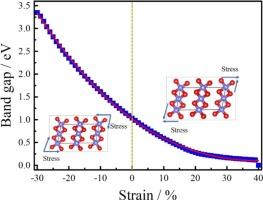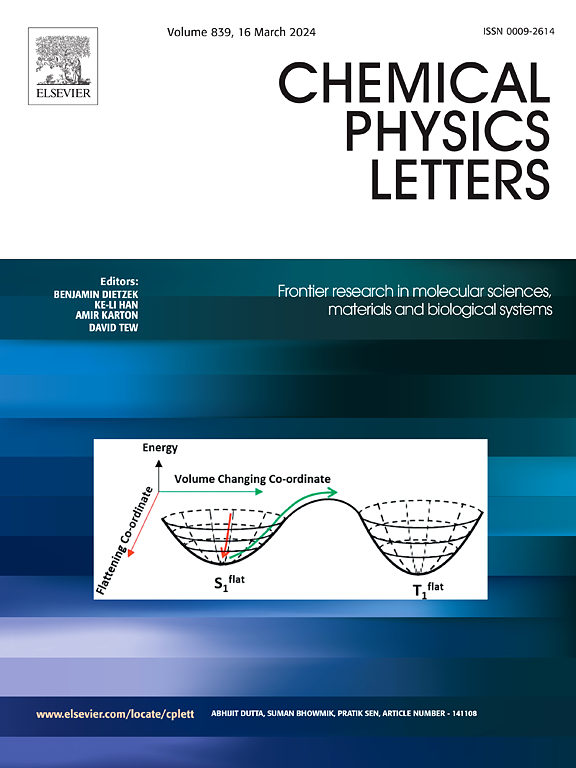PdBr 2电子结构和光学性质中应变相关函数的表征
IF 3.1
3区 化学
Q3 CHEMISTRY, PHYSICAL
引用次数: 0
摘要
PdBr2是一种具有范德华结构的窄带隙过渡金属卤化物半导体,其独特的结构使其能够构建3D、2D和1D结构,具有优异的物理化学性能。然而,晶体结构应变对PdBr2的结构和物理性能有显著影响。为了揭示其对应变调节器的影响机制,本文通过应变调节PdBr2的电子结构和光学性质。结果表明,PdBr2在−30% ~ 35%的应变范围内是一种G-M间接带隙半导体。由于导带的底部和价带的顶部在应变范围内不分布在布里渊区,导致带隙变化的主要因素是导带的浅层能级对应变的响应显著。拟合结果表明,PdBr2的带隙与应变之间存在Egε=a+bε+cε2+dε3的函数关系,可用于控制PdBr2的电子结构和光学性质。态密度表明,应变对Pd-4d和Br-4p的电子跃迁有显著影响。这些电子跃迁决定了PdBr2的带隙,这是导致带隙随应变变化的主要原因。介电函数实部、折射率、反射谱和电子能量损失函数随应变的变化与带隙随应变的变化相似。介质函数虚部、吸收谱、消光吸收、能量损失函数和电导率随压缩应变的增大而增大,且在高能区表现更为显著。在拉伸应变下,这四种光学性质随应变的增大而减小,且在低能区更为显著。结果表明,PdBr2的光学性质可以通过有效控制应变来调节。本文章由计算机程序翻译,如有差异,请以英文原文为准。

Characterization of the strain-correlation function in the electronic structure and optical properties of PdBr₂
PdBr2 is a narrow band gap transition metal halide semiconductor with a van der Waals structure, its unique structure enables the construction of 3D, 2D and 1D structures, and excellent physical chemical properties. However, the structure and physical properties of PdBr2 are significantly affected by the strain of crystal structure. In order to reveal the mechanism of its influence on the strain regulator, the electronic structure and optical properties of PdBr2 are regulated by strain, in this paper. The results show that PdBr2 is a G-M indirect band gap semiconductor in the strain range of −30 % ∼ 35 %. Because of the bottom of the conduction band and the top of the valence band are not distributed in the Brillouin zone in the strain range, the reason for the main factor causing the change of band gap is that the shallow energy level of the conduction band responds significantly to the strain. The fitting results show that there is a function relationship between the bandgap and strain of PdBr2, and it can be used to control the electronic structure and optical properties of PdBr2. State density shows that the electron transition of Pd-4d and Br-4p is significantly affected by strain. These electron transition determines the band gap of PdBr2, which is the main reason why the band gap changes with strain. The changes of the real part of the dielectric function, refractive index, reflection spectrum and electron energy loss function with strain are similar to the change of band gap with strain. The imaginary part of dielectric function, absorption spectrum, extinction absorption, energy loss function and conductivity increase with the increase of compressive strain, and the performance is more significant in the high energy region. Under the tensile strain, these four optical properties decrease with the increase of strain, and are more significant in the low energy region. The results show that the optical properties of PdBr2 can be regulated by effectively controlling the strain.
求助全文
通过发布文献求助,成功后即可免费获取论文全文。
去求助
来源期刊

Chemical Physics Letters
化学-物理:原子、分子和化学物理
CiteScore
5.70
自引率
3.60%
发文量
798
审稿时长
33 days
期刊介绍:
Chemical Physics Letters has an open access mirror journal, Chemical Physics Letters: X, sharing the same aims and scope, editorial team, submission system and rigorous peer review.
Chemical Physics Letters publishes brief reports on molecules, interfaces, condensed phases, nanomaterials and nanostructures, polymers, biomolecular systems, and energy conversion and storage.
Criteria for publication are quality, urgency and impact. Further, experimental results reported in the journal have direct relevance for theory, and theoretical developments or non-routine computations relate directly to experiment. Manuscripts must satisfy these criteria and should not be minor extensions of previous work.
 求助内容:
求助内容: 应助结果提醒方式:
应助结果提醒方式:


